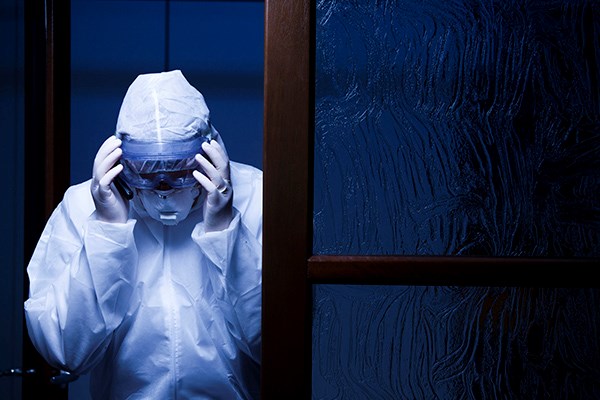How could you truly know what it's like in the intensive care unit or emergency department during the peak of the SARS-CoV-2 pandemic without experiencing it yourself?
COVID-19 continues to evolve, and hospitals in Southern California and the rest of the country are drowning.
As a new emergency medicine resident physician, I had no idea what was coming.
By the end of January 2021, our ICU reached capacity, vital equipment supply was running low, and National Guard medics were called to help our hurting hospitals. As COVID-19 cases continued to drastically increase after the holiday season, so did the need for help in the ICU. Along with other residents, I have been volunteering to cover shifts as needed.
Every couple of hours, I hear "CODE BLUE" over the hospital's system-wide loudspeaker. It's the alert that a patient has gone into cardiac arrest and spontaneous breathing has stopped. This time, the patient is a 61-year-old woman with a history of hypertension and diabetes. We run into the room, barely recognizable in our head-to-toe personal protective equipment, and begin CPR. While doing chest compressions, we sometimes have to use so much force you can hear the sound of ribs cracking beneath your hands. We place an endotracheal breathing tube down the airway and use a mechanical ventilator if they're too weak to breathe or have failed other oxygenation and ventilation therapies.
It's hour 7 into my 12+ hour night shift, and I've already lost 2 patients. "CODE BLUE" echoes again over the loudspeaker, and my stomach sinks.
As I walk through the ICU halls, there's a harrowing and profound silence intermixed with palpable tension and visible burnout from the full-time staff. Tubes, cords, intravenous catheters, and monitors consume the surroundings of patients with respiratory failure. Most of them will likely never come off the ventilator.
It's not like the movies. The end of life can be brutal, dehumanizing, and more often than not, full of suffering. It's lonely, and given the current circumstances, these patients cannot be held and comforted by their families or loved ones during their final breaths.
We try to keep them comfortable. We try to give them the physical contact families can't give right now, and we try to keep it together because we know this probably won't be the last patient this happens to tonight.
We are trying, but it's still not enough.
At the close of 2020, the estimated infection fatality rate of COVID-19 was 0.5-1%, but this may change.1,2 Not so terrible when compared to the 1918 influenza, which had a mortality of 2.5%, right?3 But with 330 million people in the United States, that's 1.65-3.3 million deaths if we continue letting the virus run rampant.4
In the first 10 months since the pandemic was recognized, the quality of our care, as well as our knowledge of this virus, improved. A 10-day course of corticosteroids has been shown to reduce mortality in critically ill patients, and a 5-day course of remdesivir is proven to shorten recovery time in hospitalized patients.5,6 We've also had a paradigm shift since the beginning of the pandemic by utilizing intermittent prone positioning, high flow nasal cannula as well as bilevel positive airway pressure ventilation to avoid intubation when possible. Despite these improvements, many important clinical questions remain unanswered. What is the proper anticoagulation regimen? Is there a role for monoclonal antibody treatment?
During these dark times, I still have hope.
Health care and front line workers head steadfast into hospital warzones each day without a moment’s hesitation. And now we have a vaccine. Two, in fact, that have been shown to be 95% effective with minimal adverse side effects. These have been studied using randomized controlled clinical trials with more than 70,000 participants between Pfizer and Moderna alone.7,8 We balance the risks and benefits of a treatment every day in medicine, and I encourage each person to educate themselves, family, friends, and patients about the vaccine. This vaccine, in combination with continued physical distancing and mask use is how we end the pandemic.
I'm grateful for my residency program leadership, co-residents, and partner whose unwavering support fuels me to continue battling this global crisis. It is humbling to work alongside the nurses, respiratory therapists, attending physicians, and many more fellow hospital staff who make each day possible. COVID-19 continues to challenge our resilience - but through extending empathy and compassion with one another, we can move through this unprecedented time together.
Acknowledgment: To my life-partner, Kay, for her insight, tireless edits, and unfaltering love.
Disclaimer: This research was supported (in whole or in part) by HCA Healthcare and/or an HCA affiliated entity. The views expressed in this publication represent those of the author(s) and do not necessarily represent the official views of HCA Healthcare or any of its affiliated entities.
References
- World Health Organization. Estimating mortality from COVID-19. Accessed January 4, 2021.
- Ives-Tallman C, Guest B. Novel Coronavirus 2019 (COVID-19). EM:RAP CorePendium. Accessed January 4, 2021.
- Taubenberger JK, Morens DM. 1918 Influenza: the Mother of All Pandemics. Emerg Infect Dis. 2006;12(1):15-22.
- EM:RAP. COVID-19: Not That Bad, Yet Terrible. Accessed January 4, 2021.
- Sterne JAC, Murthy S, Diaz JV, et al. Association Between Administration of Systemic Corticosteroids and Mortality Among Critically Ill Patients With COVID-19. JAMA. 2020;324(13):1330.
- Beigel JH, Tomashek KM, Dodd LE, et al. Remdesivir for the Treatment of Covid-19 — Final Report. N Engl J Med. 2020;383(19):1813-1826.
- Jackson LA, Anderson EJ, Rouphael NG, et al. An mRNA Vaccine against SARS-CoV-2 — Preliminary Report. N Engl J Med. 2020;383(20):1920-1931.
- Polack FP, Thomas SJ, Kitchin N, et al. Safety and Efficacy of the BNT162b2 mRNA Covid-19 Vaccine. N Engl J Med. 2020;383(27):2603-2615.



